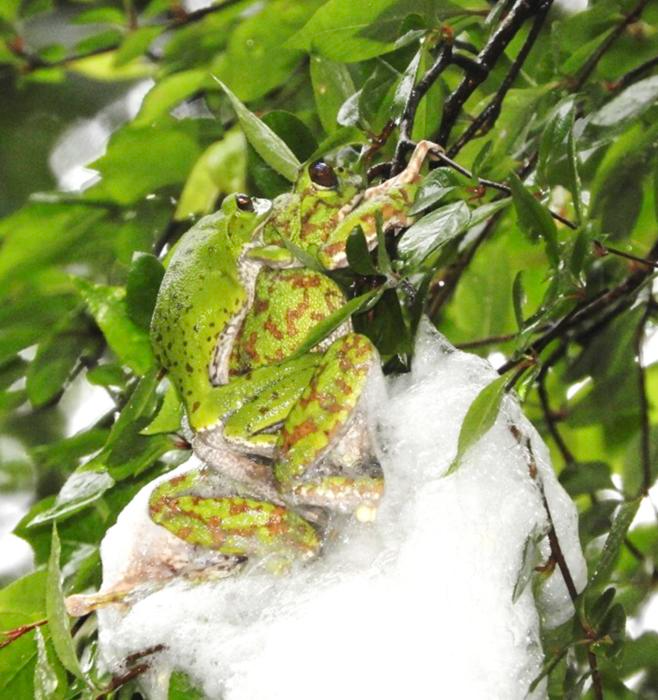There are some peculiar habits that tree frogs have when it comes to laying eggs. They frequently deposit their eggs on the ground rather than the tree branches where they typically reside. However, given that it exposes its eggs to potential predators like snakes, why would a tree frog take such a risk?
 A tree frog: female (larger individual below) laying eggs, which are protected by the 'foam nest' and male (smaller individual above). Image Credit: Ichioka Yukio
A tree frog: female (larger individual below) laying eggs, which are protected by the 'foam nest' and male (smaller individual above). Image Credit: Ichioka Yukio
A group from Nagoya University in Japan investigated the spawning habits of the forest green tree frog (Zhangixalus arboreus), a species that is frequently found in Japanese forests, to solve this mystery. They discovered that the frog's actions were probably a part of a plan to stay away from the colder surroundings of tree branches and toward the warmer surroundings of the ground. Their results were published in Ecology and Evolution.
To protect their eggs, bubbling secretions from their bodies allow tree frogs to make characteristic “foam nests.” Usually white or light in color, the foam nest resembles a mass of tiny bubbles gathered together. These incredible amphibians use air whipping to produce a frothy, foamy substance that they secrete from their bodies to build their nests. Because they offer a stable, biocompatible environment that shields eggs and embryos from predators, these nests are crucial for the protection of developing eggs and embryos.
Tree frogs employ a combination of techniques when constructing their nests. The frogs construct their nests on tree branches that hang over ponds and marshes and on the ground occasionally. Yukio Ichioka, a Doctoral Candidate at the Graduate School of Bioagricultural Sciences, and Professor Kajimura, his adviser, questioned their actions.
In some areas, we find foam nests on the ground around ponds, even though there are trees suitable for building bubble nests said. However, it was a mystery as to why they lay their eggs on the ground where they are at risk of predation by their natural enemies.”
Yukio Ichioka, Study Lead Researcher and Doctoral Candidate, Graduate School of Bioagricultural Sciences
The researchers compared the temperatures inside a sample of ground-based nests, a sample of nests atop tree branches, and the ambient temperature in order to gain a better understanding of this behavior. By calculating the proportion of eggs that developed into tadpoles and those that did not, they were also able to determine the hatchability rate of eggs.
Ichioka and Kajimura discovered that tree frogs have a fairly intricate method for laying their eggs. The interior temperature of the ground-based foam nests was higher than the ambient temperature during periods of low air temperature.
The effect of heat retention was most noticeable at night when the temperature was lower. The likelihood of the eggs hatching was enhanced by the above-ground foam nests, which shielded them from freezing temperatures. The fact that the eggs’ hatchability rate was higher at ground level than it was at tree level provided evidence for this conclusion.
According to their research, laying tree frog eggs on the ground may have previously been overlooked as a useful adaptation. It means that if they lay their eggs on the ground, the cold will not harm them. Forest green tree frogs can occasionally inhabit regions that are elevated above sea level, making this an important behavior.
These findings will be an important contribution to understanding the evolution of spawning behavior in amphibians. They will also shed light on the adaptation strategies of forest organisms to the thermal environment. Our research is important for the relationships between climate and animal behavior and can contribute to understanding the evolution of behavior, especially in the current environment.”
Yukio Ichioka, Study Lead Researcher and Doctoral Candidate, Graduate School of Bioagricultural Sciences
The researchers are keen to test their theory with other frogs. Ichioka added, “We plan to begin research on Zhangixalus viridis in Okinawa in April 2024.”
Ichioka is excited about the prospect of further research.
Ichioka concluded, “Frogs other than Z. arboreus also make foam nests, so our findings can provide more insights into their ecology and adaptive evolution.”
Source:
Journal reference:
Ichioka, Y. & Kajimura, H. (2024) Arboreal or terrestrial: Oviposition site of Zhangixalus frogs affects the thermal function of foam nests. Ecology and Evolution. doi.org/10.1002/ece3.10926